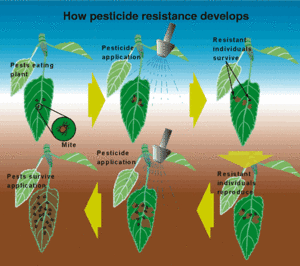Food securityResistance shapes the discovery of new insecticides
Recent news around the world has focused on the dangers of antibiotic resistance. – and the CDC estimates over two-million illnesses and 23,000 deaths occurred in 2013 as a result of antibiotic resistance in bacteria and fungus. But what of another type of resistance which can also have a huge impact on the population: that to insecticides? Livestock, for example, are affected by buffalo flies; farmers and customers are familiar with the total devastation caused by fruit flies; malaria mosquitoes and bed bugs are becoming more resistant to existing chemicals. Even our pets are affected: fleas and ticks are continuing their march, leading to a need for newer, often more expensive synthetic chemistries. The price of insecticide resistance — in the form of R&D costs for new compounds — is passed from chemical companies, to farmers, to consumers.

Effectiveness of pesticide yields resistent pests // Source: msu.edu
Recent news around the world has focused on the dangers of antibiotic resistance. But what of another type of resistance which can also have a huge impact on the population: that to insecticides?
Antibiotic resistance occurs when a bacteria, or fungus, adapts so it can survive in the presence of an antibiotic (a drug that slows bacterial growth, or kills the bacteria). Superbugs are multi-drug resistant bacteria, meaning they are able to survive in the presence of several types of antibiotics, and they are becoming increasingly common in Australia and overseas.
The U.S. Centers for Disease Control and Prevention (CDC) is the country’s watchdog for human health. The CDC estimates over two-million illnesses and 23,000 deaths occurred in 2013 as a result of antibiotic resistance in bacteria and fungus.
Yet antibiotic resistance is not the only form of resistance we should be worrying about.
Insecticide resistance
The concept of “resistance” also applies to another set of chemistry that we use to protect ourselves, our food supply, and our environment: insecticides. Recently, I published an article in the open-access journal Insects about how insecticide resistance shapes insecticide discovery.
Older insecticides were broad-spectrum, persistent chemicals that would kill other living things along with insects. Due to concerns about danger to people, pets, and the environment, new insecticides are subject to rigorous safety testing.
Insecticides are now tested for safety against humans, pets, and livestock, as well as for possible contamination in groundwater and other environments.
In Australia, since 1994 all insecticides have had to be approved by the Australian Pesticides and Veterinary Medicines Authority (APVMA). Despite the long history of excellence in Australian science, only seven new pest management products have been developed entirely within the country.
The road to new discoveries
My research program is focused on discovering and characterizing novel insecticides. Previously, we published the initial and structural discovery of an orally-active insecticidal peptide (OAIP) from the venom of a native Australian tarantula.
Just this month, the first bioinsecticide from spider venom was approved by the U.S. Environmental Protection Agency (EPA). Vestaron Corporation has developed this compound, a naturally-occurring peptide isolated from spiders, which has been approved for use on a wide variety of crops and has shown no toxicity to fish, birds, or mammals (including humans).
